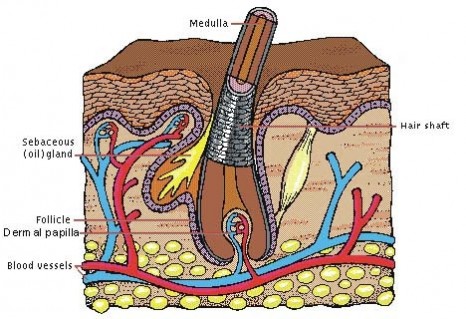Humans have around 100,000 to 150,000 hairs on the scalp. Adult Asians have around 100,000, while adult Caucasians have around 150,000. The actual number depends on the amount of hair follicles, and the density of hair follicles will decrease as we age. During childhood, the density is around 1000 / cm2, reducing to around 600/cm2 in young adulthood, and 300/cm2 or less in later life.
Hair Types
The hair follicles are formed as early as the 9th to 12th week in the fetus, and are widely present from the 4th month onwards. There are three types of hair: the Lanugo Hair in the fetus and baby; the mature fine Vellus Hair; and the mature robust Terminal Hair.
The lanugo hairs are extremely fine and soft, covering the whole fetus. They are mostly lost before birth, although occasionally some may persist in the first month of the newborn babies.
Vellus hairs usually have a length no longer than 1 - 2 cm. They are fine, have a lighter colour, and are present all over the body. They are not connected with the sebaceous (oily) glands, and therefore do not have oily secretion. The “mustaches” in females consist of vellus hair, whereas those in the males are terminal hair.
Terminal hairs are regional and do not cover the whole body. They are those on the scalp, the mustaches in males, the underarm hairs, the pubic hairs, and the hairs on the limbs. They have a growth cycle, and are connected to sebaceous glands, with oily secretion coming out from the hair follicles to lubricate the skin.
The Hair Growth Cycle
The hair shafts are made from the hair follicles. The growth starts from budding, to getting strong, thick, and increase in length, and finally shed off. The cycle can be divided into three phases: growth phase (Anagen); degradation phase (Catagen); and resting phase (Telogen).Anagen The hair bulb and the follicle are closely adhered. The follicle continuously produces new hair shaft. The hair growth will last for 2 to 4 years and the average rate is about 1 cm per month. The longer the anagen phase, the longer the hair will be. This depends on the race, the sex, and the age. Females of course have a longer anagen phase. As we age, the anagen phase will get shorter.
Catagen The bulb and the follicle gradually separate. The bulb will form a round end and the follicle begins to stop its production of hair shaft. The hair growth is slowed down and the hair begins to degrade. This phase lasts for about 2 - 4 weeks.
Telogen The hair follicles shrink, and the hair growth come to a complete stop. This resting phase lasts for 2 - 4 months. Shedding of the hair occurs only after the next growth cycle (anagen) begins and a new hair shaft begins to emerge.
Under normal circumstances, 90 - 95% of hair is in growth phase, 5 - 10% in resting phase, and less than 1 % in degradation.
On average 50 - 100 telogen hairs are shed every day. This is normal hair loss and accounts for the hair loss seen every day in the shower and with hair combing. These hairs will regrow. A variety of factors can affect the hair growth cycle and cause temporary or permanent hair loss (alopecia) including medication, radiation, chemotherapy, exposure to chemicals, hormonal and nutritional factors, thyroid disease, generalized or local skin disease, and stress.
The Hair Structure
Hair is composed of strong structural protein called keratin. This is the same kind of protein that makes up the nails and the outer layer of skin.The hair consists of the hair shaft and the hair bulb. The bulb is closely adhered to the follicle and receives nutrients through blood supply. The stem cells in the bulb split into different cells, which are arranged concentrically as they move up the hair. After many processes of compression and hardening, these cells become dead keratin and form the tough hair shaft.
|
|
Each strand of hair shaft consists of three layers.
- An innermost layer called the medulla, which is basically empty, and only present in large thick hairs.
- The middle layer is known as the cortex, which provides strength, and both the colour and the texture.
- The outermost layer is known as the cuticle, which is thin and colorless. There are 6 - 10 layers, overlapping like the tiles on the roof, and serves as a protector of the cortex.
Below the surface of the skin is the hair root, which is enclosed within a hair follicle. At the base of the hair follicle is the dermal papilla. The dermal papilla is feed by the bloodstream which carries nourishment to produce new hair. The dermal papilla is a structure very important to hairgrowth because it contains receptors for male hormones and androgens, which regulate hair growth.


